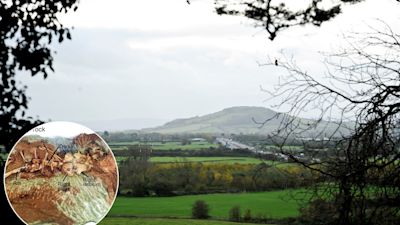'Flying reptile' that's 200 million years old discovered by Bristol University student

A Bristol University student has discovered a 200-million-year-old flying reptile in Somerset.
Researchers have revealed gliding winged reptiles were amongst the ancient crocodile residents of the Mendip Hills.
Kuehneosaurs looked like lizards but were more closely related to the ancestors of crocodilians and dinosaurs.
The discovery was made by University of Bristol Masters student Mike Cawthorne, who was researching numerous reptile fossils from limestone quarries.
These formed the biggest sub-tropical island at the time, called the Mendip Palaeo-island.
200 million years ago, the area around Bristol was an archipelago of small islands set in a warm sub-tropical sea.
What were Kuehneosaurs?
They were small animals, that could fit neatly on the palm of a hand, and there were two species, one with extensive wings, the other with shorter wings, made from a layer of skin stretched over their elongated side ribs, which allowed them to swoop from tree to tree.
Like the modern flying lizard Draco from southeast Asia, they most likely wandered about on the ground and climbed trees in search of insect prey.
When startled, or if they spotted a tasty insect flying by, they could launch themselves into the air, and land safely 10m away.
The study, published in Proceedings of the Geologists’ Association, also records the presence of reptiles with complex teeth, the trilophosaur Variodens and the aquatic Pachystropheus that probably lived a bit like a modern-day otter likely eating shrimps and small fish.
The animals either fell or their bones were washed into caves and cracks in the limestone.
"All the beasts were small," Mike Cawthorne said.
"I had hoped to find some dinosaur bones, or even their isolated teeth, but in fact I found everything else but dinosaurs.
"The collections I studied had been made in the 1940s and 1950s when the quarries were still active, and palaeontologists were able to visit and see fresh rock faces and speak to the quarrymen."
Professor Mike Benton Bristol’s School of Earth Sciences explained: “It took a lot of work identifying the fossil bones, most of which were separate and not in a skeleton.
“However, we have a lot of comparative material, and Mike Cawthorne was able to compare the isolated jaws and other bones with more complete specimens from the other sites around Bristol.
“He has shown that the Mendip Palaeo-island, which extended from Frome in the east to Weston-super-Mare in the west, nearly 30 km long, was home to diverse small reptiles feeding on the plants and insects.
“He didn’t find any dinosaur bones, but it’s likely that they were there because we have found dinosaur bones in other locations of the same geological age around Bristol."